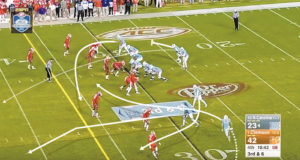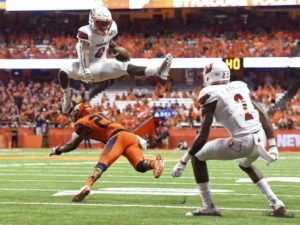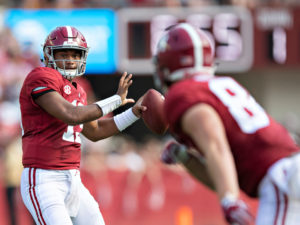College Football Power and Balanced Offenses
Isolating the Most Powerful and Balanced Offenses in College Football
For more than 15 years I’ve been handicapping college football professionally and providing information and insight about various ways to use statistics to isolate more winners. That includes both offensively and defensively, and this week we’ll take seven weeks of data and point out a positive statistical profile and list of teams that fit the parameters to assist you the rest of the season.
Every year I isolate college football’s most powerful and balanced offenses. These teams should be especially profitable the rest of the season when listed as an underdog in a weekly contest. Match-ups are always key, as is isolating value in the betting line when shopping at the online and leading sportsbooks. I’ve provided more college football winners this season isolating underdogs only, and hoping you can profit from my experience with our weekly college football picks. Now 14-11 ATS this season with 8 outright underdog winners and numerous near misses, this information below on balanced, powerful and productive offenses should help you in your own handicapping to finish the second half of the season strong.
 All FBS teams have now played 2-4 conference games, and we can use more realistic numbers and stats from selected opponents and those moving forward as teams, and especially those in the power conferences, play similar and stronger opponents.
All FBS teams have now played 2-4 conference games, and we can use more realistic numbers and stats from selected opponents and those moving forward as teams, and especially those in the power conferences, play similar and stronger opponents.
While total yards gained, yard per play and rushing and passing numbers are worthy statistics to consider, the way in which teams accumulate those yards is significant. In college football, it’s important to control or dominate the line of scrimmage. And teams that can balance their offense and attack are usually more efficient and make it more difficult for opposing defenses and coordinators to defend and prepare. Evaluating opponents and strength of schedule is another factor you must analyze once you review the numbers and statistical profiles.
 So, as we evaluate the offensive side of the ball, one specific area of strength I pay attention to at this time of year are college football teams which have strong, balanced offenses. These are your most powerful, productive and efficient offensive teams. As a guideline, I look for teams who both run and pass the ball for an average of over 200 yards-per-game. This is the college football ‘200 Club’, as offensive balance is a key component to offensive efficiency. As scoring and offensive production has increased in more recent seasons, we adjust are numbers and parameters. As of October 15, 2018 there are 19 teams that both run and pass for at least 200 yards per game.
So, as we evaluate the offensive side of the ball, one specific area of strength I pay attention to at this time of year are college football teams which have strong, balanced offenses. These are your most powerful, productive and efficient offensive teams. As a guideline, I look for teams who both run and pass the ball for an average of over 200 yards-per-game. This is the college football ‘200 Club’, as offensive balance is a key component to offensive efficiency. As scoring and offensive production has increased in more recent seasons, we adjust are numbers and parameters. As of October 15, 2018 there are 19 teams that both run and pass for at least 200 yards per game.
Bet on NCAA football and check the latest lines from Las Vegas sportsbooks!
However, offensive efficiency must also include scoring, as teams must be efficient in the red zone and also accumulate points. In addition, to strengthen the criteria, teams must:
· accumulate at least 450 yards per game
· average at least 6.0 yards per play
· score at least 30 points per game against FBS opponents
That would eliminate these teams from the chart below, but still worth watching and updating as you evaluate performances, stats, opponents and the betting line.
Boston College, LSU, Michigan, Toledo
Here are the most efficient offensive teams year-to-date, and the 15 teams that meet the current criteria of powerful and balanced offenses. These stats are taken from FBS games and opponents only. Be sure to update your stats weekly, and understand that statistical profiles are just one way of handicapping  games and match-ups. Fundamental (match-ups), situational (scheduling, look ahead, letdown) and a blend of meaningful technical parameters (patterns, ATS systems) complete the process and profiles, and you must always understand the emotional and motivational components of college football teams. Coaching, cohesiveness, injuries and weather become a bigger factor as teams push towards a strong finish the second half of the season. And of course, using every available advantage, including shopping numbers at the leading sportsbooks ensures that you’re staying on top of your game and putting yourself in the best position to win more close games and ATS results.
games and match-ups. Fundamental (match-ups), situational (scheduling, look ahead, letdown) and a blend of meaningful technical parameters (patterns, ATS systems) complete the process and profiles, and you must always understand the emotional and motivational components of college football teams. Coaching, cohesiveness, injuries and weather become a bigger factor as teams push towards a strong finish the second half of the season. And of course, using every available advantage, including shopping numbers at the leading sportsbooks ensures that you’re staying on top of your game and putting yourself in the best position to win more close games and ATS results.
YPR = Yards Per Rush; YPP = Yards Per Pass; YPPL = Yards Per Play; PPG = Points Per Game
| Team | Rushing | YPR | Passing | YPP | Total Yds | YPPL | PPG |
| Alabama | 217 | 5.2 | 350 | 13.6 | 567 | 8.4 | 53 |
| Appalachian State | 224 | 5.7 | 226 | 8.9 | 450 | 6.9 | 42 |
| Clemson | 287 | 6.9 | 244 | 8.3 | 531 | 7.3 | 41 |
| Central Florida (UCF) | 239 | 5.7 | 314 | 9.5 | 553 | 7.2 | 47 |
| Florida Atlantic | 209 | 4.8 | 256 | 8.1 | 465 | 6.1 | 32 |
| Georgia | 217 | 5.4 | 237 | 9.4 | 454 | 6.7 | 38 |
| Houston | 238 | 6.1 | 290 | 8.4 | 528 | 7.1 | 44 |
| Louisiana Lafayette | 235 | 5.9 | 224 | 9.1 | 459 | 6.9 | 32 |
| Memphis | 267 | 7.4 | 236 | 8.9 | 503 | 7.7 | 40 |
| Mississippi | 202 | 5.8 | 332 | 10.1 | 534 | 7.6 | 36 |
| Oklahoma | 209 | 6.3 | 316 | 12.5 | 525 | 8.7 | 48 |
| Penn State | 252 | 6.1 | 239 | 8.2 | 491 | 6.8 | 44 |
| South Florida | 234 | 5.6 | 248 | 8.1 | 482 | 6.4 | 35 |
| Syracuse | 229 | 5.1 | 237 | 7.1 | 466 | 5.7 | 39 |
| Western Michigan | 202 | 5.1 | 276 | 8.2 | 478 | 6.4 | 31 |
| Others | |||||||
| Boston College | 204 | 4.2 | 216 | 8.1 | 420 | 5.5 | 36 |
| LSU | 205 | 4.6 | 210 | 7.2 | 415 | 5.4 | 32 |
| Michigan | 217 | 5.3 | 207 | 8.2 | 424 | 6.3 | 38 |
| Toledo | 200 | 4.6 | 204 | 7.2 | 404 | 5.4 | 38 |
Currently 15 teams fit the criteria indicated with the four additional teams close. The last two years at this time there were 12 and 17 teams respectfully that met the criteria. Clearly there are some strong offensive teams that score plenty with pass heavy offenses and others that rely on run heavy or option attacks. You can gain an edge in match-up handicapping for selected games, but teams that have balance are often more consistent and certainly ones to support when in an underdog role.
Currently there are 34 teams that rush for at least 200 yards per game, the same as last year at this time (26% of the 130 FBS teams). There are 43 teams that pass for at least 250 ypg, down from 53 teams at the same time last year.
Teams that run for 200+ and pass for 250+ are your most powerful and balanced offensive teams – there are currently 6 such teams:
· Alabama
· Central Florida (UCF)
· Florida Atlantic
· Houston
· Mississippi
· Oklahoma
The ability to run the football effectively also helps on the defensive side of the ball by keeping a defense fresh. When a defense is on the field for more plays per game and facing a hurry-up and spread passing attack, it can wear them out. But clearly if a team struggles at the point of attack and cannot stop or slow an opponent’s running game, it will effect more areas of the game including ball control and the clock. So that’s why having a balanced offensive attack is more potent and efficient and can be counted on when  an opponent team does slow one facet of the offense. And it’s also important to have strong point of attack play and be able to run the ball effectively if the weather is an issue and prevents production in the passing game.
an opponent team does slow one facet of the offense. And it’s also important to have strong point of attack play and be able to run the ball effectively if the weather is an issue and prevents production in the passing game.
Currently, there are 35 teams that average at least 450 total yards-per-game on offense. Of course, you need to evaluate previous opponents and adjust accordingly based on opponent strength of schedule and the upcoming schedule and opponents defensive strengths to feel more confident in your team’s ability to sustain their offensive production and balance. The power teams can be attractive teams to bet on, especially as an underdog. If our power team has a strong defense to support this high-powered balanced offense then they often become an even stronger play in an underdog role; a situation to watch for and one I’ve used many times as it arises.
From the current list, these teams from the balanced offensive power list also feature top-25 defenses in yards against: Alabama, Appalachian State, Clemson, Georgia and Michigan.
 Good defensive coordinators can take an average defense and slow down another team’s offense if they lack balance. Thus, high-powered passing teams that lack a solid running game are susceptible to an inconsistent performance, especially if their own defense is not up to par to hold down an opponent.
Good defensive coordinators can take an average defense and slow down another team’s offense if they lack balance. Thus, high-powered passing teams that lack a solid running game are susceptible to an inconsistent performance, especially if their own defense is not up to par to hold down an opponent.
Update your numbers weekly and pay attention to on-field performance, especially vs. quality opponents. Yards-per-play differential is something to incorporate into your weekly handicap and match-up analysis, and note turnovers, special team’s scores and turnover margin when evaluating box scores and not just the final score and result. You’ll be laying a pretty big price with some of these power teams in the weeks ahead, so continue to evaluate on-field performance and dig deep into the injury reports as well. Pay attention to key losses and how a team performs so you can project letdown situations and recognize when a team has a match-up edge. As you become more proficient in evaluating team’s strengths and weaknesses, you’ll find yourself with more tap-in birdies, and build your bankroll by getting the green.
Check out the leading online sportsbooks, including those with reduced juice, and profit not only from my experience, but those well-established bookmakers and sportsbooks.

 Twitter
Twitter Facebook
Facebook